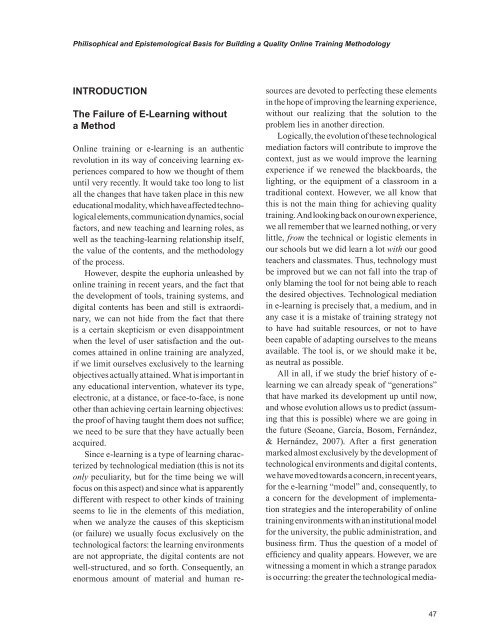Advances in E-learning-Experiences and Methodologies
You also want an ePaper? Increase the reach of your titles
YUMPU automatically turns print PDFs into web optimized ePapers that Google loves.
Philisophical <strong>and</strong> Epistemological Basis for Build<strong>in</strong>g a Quality Onl<strong>in</strong>e Tra<strong>in</strong><strong>in</strong>g Methodology<br />
IntroductIon<br />
the Failure of e-Learn<strong>in</strong>g without<br />
a method<br />
Onl<strong>in</strong>e tra<strong>in</strong><strong>in</strong>g or e-learn<strong>in</strong>g is an authentic<br />
revolution <strong>in</strong> its way of conceiv<strong>in</strong>g learn<strong>in</strong>g experiences<br />
compared to how we thought of them<br />
until very recently. It would take too long to list<br />
all the changes that have taken place <strong>in</strong> this new<br />
educational modality, which have affected technological<br />
elements, communication dynamics, social<br />
factors, <strong>and</strong> new teach<strong>in</strong>g <strong>and</strong> learn<strong>in</strong>g roles, as<br />
well as the teach<strong>in</strong>g-learn<strong>in</strong>g relationship itself,<br />
the value of the contents, <strong>and</strong> the methodology<br />
of the process.<br />
However, despite the euphoria unleashed by<br />
onl<strong>in</strong>e tra<strong>in</strong><strong>in</strong>g <strong>in</strong> recent years, <strong>and</strong> the fact that<br />
the development of tools, tra<strong>in</strong><strong>in</strong>g systems, <strong>and</strong><br />
digital contents has been <strong>and</strong> still is extraord<strong>in</strong>ary,<br />
we can not hide from the fact that there<br />
is a certa<strong>in</strong> skepticism or even disappo<strong>in</strong>tment<br />
when the level of user satisfaction <strong>and</strong> the outcomes<br />
atta<strong>in</strong>ed <strong>in</strong> onl<strong>in</strong>e tra<strong>in</strong><strong>in</strong>g are analyzed,<br />
if we limit ourselves exclusively to the learn<strong>in</strong>g<br />
objectives actually atta<strong>in</strong>ed. What is important <strong>in</strong><br />
any educational <strong>in</strong>tervention, whatever its type,<br />
electronic, at a distance, or face-to-face, is none<br />
other than achiev<strong>in</strong>g certa<strong>in</strong> learn<strong>in</strong>g objectives:<br />
the proof of hav<strong>in</strong>g taught them does not suffice;<br />
we need to be sure that they have actually been<br />
acquired.<br />
S<strong>in</strong>ce e-learn<strong>in</strong>g is a type of learn<strong>in</strong>g characterized<br />
by technological mediation (this is not its<br />
only peculiarity, but for the time be<strong>in</strong>g we will<br />
focus on this aspect) <strong>and</strong> s<strong>in</strong>ce what is apparently<br />
different with respect to other k<strong>in</strong>ds of tra<strong>in</strong><strong>in</strong>g<br />
seems to lie <strong>in</strong> the elements of this mediation,<br />
when we analyze the causes of this skepticism<br />
(or failure) we usually focus exclusively on the<br />
technological factors: the learn<strong>in</strong>g environments<br />
are not appropriate, the digital contents are not<br />
well-structured, <strong>and</strong> so forth. Consequently, an<br />
enormous amount of material <strong>and</strong> human resources<br />
are devoted to perfect<strong>in</strong>g these elements<br />
<strong>in</strong> the hope of improv<strong>in</strong>g the learn<strong>in</strong>g experience,<br />
without our realiz<strong>in</strong>g that the solution to the<br />
problem lies <strong>in</strong> another direction.<br />
Logically, the evolution of these technological<br />
mediation factors will contribute to improve the<br />
context, just as we would improve the learn<strong>in</strong>g<br />
experience if we renewed the blackboards, the<br />
light<strong>in</strong>g, or the equipment of a classroom <strong>in</strong> a<br />
traditional context. However, we all know that<br />
this is not the ma<strong>in</strong> th<strong>in</strong>g for achiev<strong>in</strong>g quality<br />
tra<strong>in</strong><strong>in</strong>g. And look<strong>in</strong>g back on our own experience,<br />
we all remember that we learned noth<strong>in</strong>g, or very<br />
little, from the technical or logistic elements <strong>in</strong><br />
our schools but we did learn a lot with our good<br />
teachers <strong>and</strong> classmates. Thus, technology must<br />
be improved but we can not fall <strong>in</strong>to the trap of<br />
only blam<strong>in</strong>g the tool for not be<strong>in</strong>g able to reach<br />
the desired objectives. Technological mediation<br />
<strong>in</strong> e-learn<strong>in</strong>g is precisely that, a medium, <strong>and</strong> <strong>in</strong><br />
any case it is a mistake of tra<strong>in</strong><strong>in</strong>g strategy not<br />
to have had suitable resources, or not to have<br />
been capable of adapt<strong>in</strong>g ourselves to the means<br />
available. The tool is, or we should make it be,<br />
as neutral as possible.<br />
All <strong>in</strong> all, if we study the brief history of e-<br />
learn<strong>in</strong>g we can already speak of “generations”<br />
that have marked its development up until now,<br />
<strong>and</strong> whose evolution allows us to predict (assum<strong>in</strong>g<br />
that this is possible) where we are go<strong>in</strong>g <strong>in</strong><br />
the future (Seoane, García, Bosom, Fernández,<br />
& Hernández, 2007). After a first generation<br />
marked almost exclusively by the development of<br />
technological environments <strong>and</strong> digital contents,<br />
we have moved towards a concern, <strong>in</strong> recent years,<br />
for the e-learn<strong>in</strong>g “model” <strong>and</strong>, consequently, to<br />
a concern for the development of implementation<br />
strategies <strong>and</strong> the <strong>in</strong>teroperability of onl<strong>in</strong>e<br />
tra<strong>in</strong><strong>in</strong>g environments with an <strong>in</strong>stitutional model<br />
for the university, the public adm<strong>in</strong>istration, <strong>and</strong><br />
bus<strong>in</strong>ess firm. Thus the question of a model of<br />
efficiency <strong>and</strong> quality appears. However, we are<br />
witness<strong>in</strong>g a moment <strong>in</strong> which a strange paradox<br />
is occurr<strong>in</strong>g: the greater the technological media-


